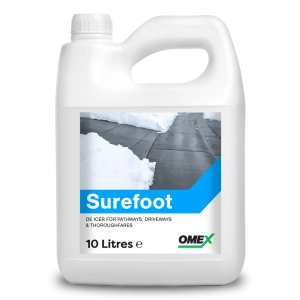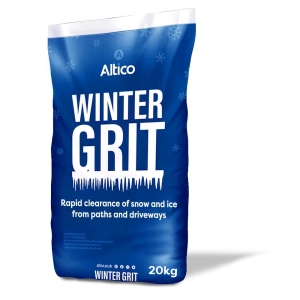There are all sorts of home remedies for de-icing, some a little more madcap than others. We’ve reviewed some of the oddest (so you don’t have to!) and left you with our best recommendation.
But before you start any de-icing activity, if you have loose snow, make sure you have removed most of it with a shovel first. You might find there is no ice underneath, in which case you’re good to go. If compacted snow remains or you notice ice underneath – read on!
Salt-based solutions
Most of us know that salt on ice helps to prevent slips and can stop overnight refreezing if applied correctly during the day.
White de-icing salt is cleaner than brown rock salt but probably doesn’t provide quite the traction. That’s because brown rock salt contains sand for added grip.
However, we’re not a huge fan of salt here at Agrigem. Firstly, rock salt is corrosive on concrete, secondly, it can harm plants, and thirdly it can be messy – especially brown rock salt – leaving you with a large clean up job once the ice has gone. It can also leave a residue on cars from spray.
Calcium chloride, magnesium chloride, and potassium chloride will all melt ice without the risk of surface damage, but they can be less effective, so select carefully.
Grit and sand solutions
Technically, grit and sand are not de-icers – they won’t melt snow or ice, but they will give you a bit of grip to make your trip to the car a little safer.
However, once the ice and snow have gone, the sand and grit will remain, meaning you still have to clear it away.
In addition, neither sand nor grit will work particularly well on soft snow – it will sink down meaning your feet are still going to make contact with the snow, and so the risk of slipping remains.
If you do opt for grit or sand, use it on ice, frost and packed snow only, and spread it out as evenly and consistently as you can.
Hot water
This one deserves its own category! While it might be tempting to quickly boil the kettle and pour it over the driveway, proceed with caution.
Depending on the air and ground temperatures, ice melted with hot water can refreeze very quickly, giving you a potentially tiny window to walk on the ice-free surface.
For this reason, we don’t recommend using hot water on its own, although adding rubbing alcohol and a few drops of dish soap to a larger volume of hot water can help the ice stay melted for longer.
However, as with salt, this solution can damage plants, so it is not recommended.
Home products
Some odder methods of melting driveway ice include using sugar beet juice - not that you’re likely to have that in your cupboard, but it has been known to lower the melting point of ice and is safe for pets.
Some swear by coffee grounds which act a little like grit and sand to provide traction and help to melt the ice faster as their dark colour will absorb more sunlight than the surrounding ice.
Vinegar can be mixed with hot water to help melt ice and prevent refreeze, but you may find you upset your neighbours as the smell is likely to be very strong!
Cat litter has also been known to be effective as a de-icer and can help with traction. However, most litter products are clay-based, meaning contact with liquid can make them sticky. This is therefore not recommended as clearing it up after the ice has gone can be an extensive task.
And finally, fertilisers that are high in nitrogen can help lower the melting point of ice without damaging your driveway. However, it can make a mess, and you will need to ensure it is cleaned away once the ice has melted.

De-icers
Products that are designed specifically for the job are always going to come top of our list for their speed of action, and effectiveness.
Look for a high-quality de-icer that will not be corrosive - like salt - will not harm the environment and poses little risk to pets.
Our top recommendation is Surefoot De-icer. This product was created using technology developed for the aviation industry, it has a very low environmental impact and will work to minus 50°C.
It can also be used safely on grass and driveway surfaces and works well if applied before ice and frost is due – meaning you don’t need to get up half an hour earlier to clear driveway ice!
Applying de-icer
- Apply evenly: Spread the de-icer evenly across the icy areas of your driveway. Use a watering can with a fine rose or a sprayer for larger driveways - making sure to avoid spraying over vehicles. Unused Surefoot de-icer can be poured back into the drum making it cost-effective and simple to use.
- Use the correct amount: Follow the manufacturer’s instructions for the recommended application rates.
- Reapply if necessary: For thick or stubborn ice, you may need to reapply the de-icer, although this is unlikely to be required with a product like Surefoot as it will act immediately and will be very effective at melting ice.
Whichever system you use to remove ice and frost from your driveway, make sure you wear sturdy boots and use gloves if using de-icer.





